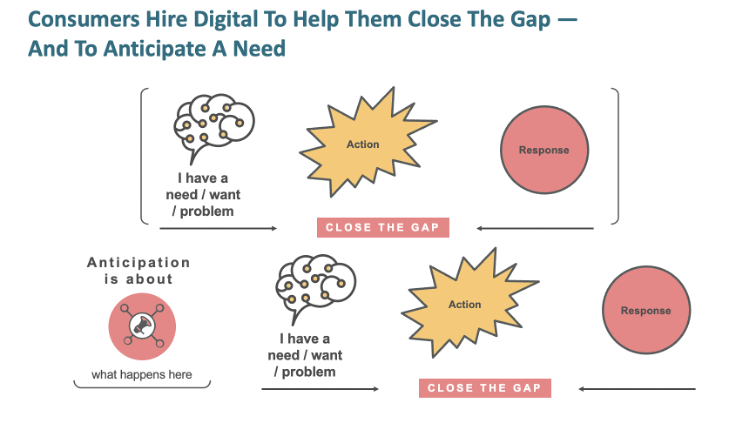Combining Data Experience Design and Journey Mapping
As I have mentioned in other articles in our newsletter, journey mapping must change to address the realities of today’s customer-centricity. We work in a very different business environment today. Generative AI is changing how people interact with products. Augmented and Virtual Reality is burgeoning. Technology, in general, is exploding.
And customers have come to expect dramatically better performance from their tools.
Traditional journey mapping places a lot of emphasis on the ideal path through an experience—often times by pointing out the trouble spots in a generalized representation of the experience. The focus is on the phases that large groups of people go through to complete an activity.
This is helpful, but it’s not sufficient for guiding design today.
How to Anticipate Customer Needs
For as long as there have been businesses serving customer needs, the model of consumer behavior has been this:
The customer has a need. The customer decides how to solve for the need. Do they decide to purchase, consume/use something they have, or try to troubleshoot the situation. Based on their decision, the company responds by trying to tailor their offerings to the customer.
But increasingly, this is what people are doing with their technology:
They expect their smart and genius technology to anticipate their need/problem/want. They expect their tools to provide the recommended approach before they even know their need.
Would you hire a navigation system today to guide you if that system couldn’t anticipate road closures, alternative routes, and stops along the way? Of course not.
Furthermore, customers expect their tools to allow them to close the gap between thought and action. So, if a journey map shows a multiphased process that the customer should ideally go through (like the example above), the customer will use smart and genius tools to expedite the process.
Each generation of smarter solutions eliminates entire phases of a journey map.
The Answer is Data Experience Design
To help a company be able to anticipate customer needs—in the moment when they are likely to need the help—requires companies to change the way they think about data. As I’ve pointed out in chapter 2 of the Experience Strategy book project, companies need rethink the way that they understand data.
Let’s look at how companies are currently using data to inform journey maps.
A company will often use sales data, process data, web traffic, and CX findings to help them lay out the phases of the journey map. Then, they will set goals for each phase of the journey map. Did they see increased sales in the deciding phase? Did they see high CX scores during the using phase?
That sounds great until you realize that what the customer wants is for the phase to go away completely. Close the gap between thought and action; anticipate my needs in the moment.
That’s why we at Stone Mantel have been researching new frameworks to understand how to use data in experiences. Here’s the culmination of a decade of research in one simple chart.
Not all data is important. The most important data is data that supports the job the customer is trying to get one. As a company, you need to know what is the job to get done. For navigation systems, the job is to get a person from point A to point B. Then, the company uses techniques that encourage the customer to share more data that helps the company tailor the experience. The company might encourage the customer to share their home address or share their favorite grocery store.
Next, the company uses the data—and this is so important—to help the customer at their point of use. It makes absolutely no sense for a customer to share data with a navigation system if that system cannot help the customer when they are trying to get from point A to B.
But the same holds true for all products. If you are gathering data from your customers, use it to make their experience better. Don’t use it to monetize your customers!
If the company supports the customer at their point of use, the customer will share even more data. That data should be used to help the company anticipate customer needs. If the customer has been at work all day, the navigation system should anticipate road closures and recommend the fastest way home—before the customer thinks to request it.
Journey maps that use these four principles will prepare the company for the real future of experience design.
Want to learn more? Reach out to us HERE
Dave Norton, Ph.D., is the founder and principal of Stone Mantel, a research-led consultancy at the forefront of customer and employee experience strategy.





